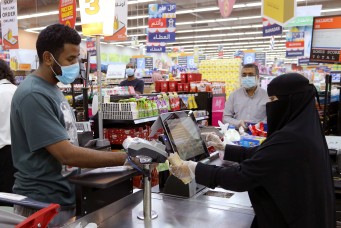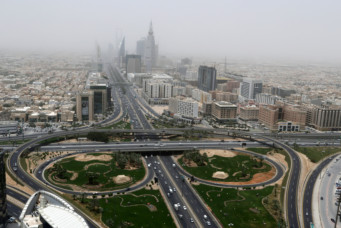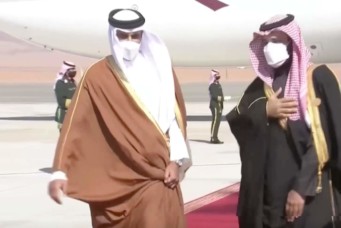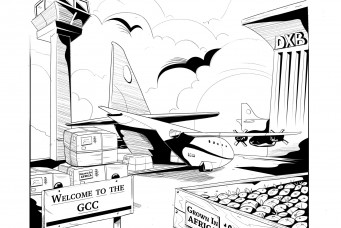Competing Economic Visions in the Gulf
Economic visions offer regional governments roadmaps for development, but they can also serve as a tool for measurement and—ultimately—accountability
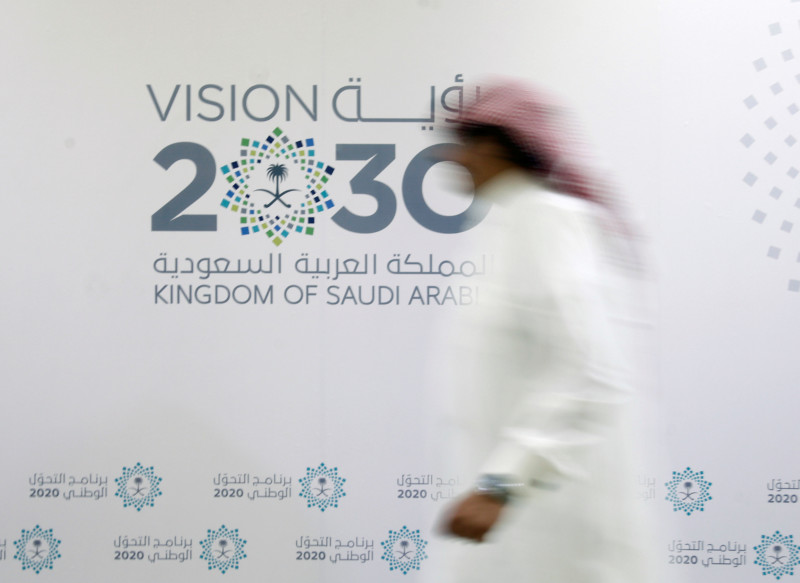
A man walks past the logo of “Vision 2030,” Jeddah, Saudi Arabia, June 7, 2016. Faisal Al-Nasser/Reuters
The governments of the Gulf Cooperation Council (GCC) have long released ambitious economic and developmental “visions” that detail their goals for the future. While GCC states exhibited impressive growth trajectories throughout the late 20th century and early 2000s, it is difficult to credit past visions alone for rapid socioeconomic advancements. However, they could prove beneficial in the long run as the Gulf eases off its hydrocarbon dependency and further opens itself up to the world.
The abundant availability of hydrocarbon resources has so far served as the primary fuel behind regional development trends. Proceeds from the oil and gas sector continue to constitute the majority—in many cases at least 70 percent— of public sector revenues, despite long-standing economic diversification efforts to reduce the region’s dependency on hydrocarbon resources. This dependency increases vulnerabilities. When oil prices plunged to historic lows in 2020, GCC governments were in crisis mode. As oil prices rebounded in 2021, Gulf officials focused on how to best support economic recoveries.
A confluence of economic tailwinds and headwinds await Gulf policymakers in 2022. On the one hand, oil prices are staying higher for longer, offering sustained fiscal relief to regional economies battered by the 2020 oil price slide. According to U.S. Energy Information Administration forecasts, Brent crude oil averaged $70.89 per barrel in 2021, up from $41.69 in 2020, and will increase to a slightly higher price of $74.95 throughout 2022. On the other hand, international momentum behind climate change-related initiatives and the widespread adoption of environmental, social, and governance criteria in global investments threaten the comparative advantages of hydrocarbon-rich Gulf economies.
As the strictest COVID-19-related travel measures began to fade, GCC countries started opening their borders to much-needed businesspeople and tourists.
Dubai commenced Expo 2020 in October 2021, after a one-year delay, and Qatar is finalizing preparations to host the 2022 FIFA World Cup in November and December. However, new COVID-19 variants, such as Omicron, pose major obstacles to hosting international commercial and sporting events or attracting global tourists.
Fairly or not, GCC vision documents will serve as a benchmark for whether regional governments can adapt their economies to a rapidly evolving world. Existing and future visions can offer regional governments a development roadmap for the post-coronavirus era, but these documents also provide a means for measurement and, ultimately, accountability.
Visions Worth Watching
The vision guiding development trends in Saudi Arabia is a key space to watch. Saudi Vision 2030, often considered the brainchild of Crown Prince Mohammed Bin Salman, has generated substantially more excitement since its launch in 2016 than the visions of neighboring countries. The Public Investment Fund, which functions as the kingdom’s investment catalyst, lies at the heart of Vision 2030. The Saudi sovereign wealth fund not only wields growing authority, but also oversees an expansive domestic and international mandate.
The sheer scale of Saudi Arabia’s envisioned transformation can be gleaned from the vision’s three broad pillars: a thriving economy, a vibrant society, and an ambitious nation. The potential impact associated with progress in these domains is enormous. With an estimated population of 34.8 million people, of which the majority are Saudi citizens, Saudi Arabia’s demographics dwarf those of neighboring states. The total population of the remaining GCC states stood at 23.8 million in 2020, according to the World Bank. Moreover, Saudi Arabia accounted for 49.8 percent of the nominal gross domestic product of all six GCC countries in 2020.
The Emiratis view the developments in Saudi Vision 2030 with a mixture of encouragement and consternation. Publicly, Emirati officials describe Saudi Arabia’s modern development trajectory as a net positive for the region, citing the benefits of healthy competition. Privately, many worry that economic transformations in Saudi Arabia threaten to disrupt key sectors and industries in the United Arab Emirates (UAE)—from trade and logistics to tourism and entertainment. The UAE possesses economic visions and strategies, too; however, these plans are decentralized among the country’s emirates, reflecting a federal structure that affords substantial economic autonomy to emirate-level governments. For example, the Abu Dhabi Economic Vision exists alongside the Dubai Industrial Strategy 2030.
UAE officials are embarking on longer-term planning, with some initiatives spanning the next fifty years. In September 2021, the UAE government announced the “Projects of the 50” scheme to accelerate the country’s development over the next five decades. In January 2019, Dubai’s ruler, Sheikh Mohammed Bin Rashid Al Maktoum, announced a fifty-year charter for the emirate. The charter contains nine articles intended to enhance Dubai’s socioeconomic environment. These various future-oriented plans constitute a multifaceted strategy by the UAE to retain its competitive economic edge over neighboring states.
Qatar and Kuwait can exert substantial influence at the margins of the Gulf region’s broader economy, and within niche sectors and industries. Yet, even the most successful vision implementation programs in these smaller GCC countries are unlikely to transform the broader region. The Qatar National Vision 2030 aims to create “an advanced country…capable of sustaining its own development and providing for a high standard of living for all its people for generations to come”. Qatar has invested heavily in creating a world-class education sector and high-tech logistics hubs. Kuwait Vision 2035 seeks to “restore the regional leadership role of Kuwait as a financial and commercial hub,” while also bolstering the country’s private sector. However, the weaker economic foundations of the northern Gulf countries of Iraq and Iran pose a significant challenge to Kuwait’s future development.
Government officials in Oman and Bahrain are preoccupied with avoiding future economic crises and mitigating risks associated with shocks, given significant fiscal constraints in both countries. Oman Vision 2040, which Sultan Haitham Bin Tariq oversaw before assuming the throne, mentions “Moving Forward with Confidence” as its tagline—an appropriate sentiment after the passing of longtime ruler Sultan Qaboos Bin Said and the emergence of the coronavirus in early 2020.
Bahrain Economic Vision 2030 focuses on sustainability and is closely associated with the influential Economic Development Board. Since the vision’s launch in 2008, the Bahraini government has undertaken a series of fiscal adjustment programs to shore up its finances. Growing levels of government debt remain a concern: Bahrain’s general government gross debt as a percentage of gross domestic product is forecasted to reach 139.6 percent in 2026, up from 123.3 percent in 2021.
Competitive Friction Between Saudi Arabia and the UAE
The GCC’s two largest economies—Saudi Arabia and the UAE—are jockeying to become the region’s partner of choice for international businesspeople, residents, and tourists. Throughout 2021, Saudi Arabia and the UAE unveiled major legal reforms to help attract foreign talent and businesses. In early 2021, the UAE established an official pathway to citizenship for a narrow group of nominated expatriates. Saudi Arabia began a similar citizenship program in November 2021. Just weeks after Dubai launched its delayed Expo 2020 (in October of last year), Saudi Arabia revealed that it had submitted an official request to host Expo 2030.
Some of the emerging economic policies and initiatives signal major shifts in the region’s commercial environment. In December 2021, the UAE announced a 4.5-day work week for state employees and switched the country’s weekend to Saturday and Sunday. Earlier in 2021, the Saudi government announced that, to secure government contracts, foreign firms would be required to establish a regional headquarters in the country by January 1, 2024.
As regional governments continue to promote non-oil segments of their economies, development trajectories are bound to overlap. This competitive overlap is especially apparent in the aviation and tourism industries. In June 2021, Saudi Crown Prince Mohammed Bin Salman announced plans to launch a second national airline under the umbrella of the Public Investment Fund. Any new airline would face fierce competition from Qatar Airways and the Dubaibased Emirates—two established carriers with global brand recognition.
Saudi Arabia likewise aspires to become a global tourism hub through the creation of cruise companies, new luxury tourism resorts on the Red Sea, and other entertainment and cultural offerings. Domestic tourism will play a critical role in the early development of Saudi Arabia’s tourism sector; however, longer-term growth in this emerging sector will invariably compete with international tourism sectors in neighboring states like the UAE, Bahrain, and Oman.
Envisioning the Future
The economic development lifespans of GCC states will not end with a whimper in 2030 or 2040, when most of the region’s current visions conclude. Rather, GCC visions will become increasingly complex, as each incorporates a steady stream of new sub-strategies and associated initiatives. Saudi officials, for example, launched the Saudi and Middle East Green Initiatives as well as a new National Investment Strategy over the course of 2021. GCC government officials will continue to race ahead with plans for the latter half of the century. Moreover, the UAE, Bahrain, and Saudi Arabia have pledged to achieve net zero emissions by 2050 or 2060.
Policies that focus on livability, sustainability, and climate change are in vogue across the globe. On the one hand, economic policymakers in the Gulf are eager to embrace these trends. Livable cities attract greater numbers of skilled expatriate residents, sustainable development processes pave the way for long-term growth, and greater concern for the environment addresses water scarcity and other climate change-related issues in the Gulf. On the other hand, the persistent reliance upon proceeds from the oil and gas sector for public sector revenues reflects a crude contradiction between developmental ambitions and underlying realities. Despite genuine excitement around the prospects for renewable energy in GCC states, it is unclear whether cleaner and greener energy can generate sufficient government revenues in a direct sense, or at least stimulate economic activity that yields new revenues indirectly through taxes and other fees.
Given the complexity of developmental challenges facing the region, governments will be tempted to adjust targets and unveil many more initiatives. Some new visions for development will be laudable, while others will seek to obscure the minimal progress achieved by previous vision plans. The extraordinary disruptions inflicted by the emergence of the coronavirus in 2020 offered a justifiable excuse for a rethink of economic policy objectives and a recalibration of the means for achieving these goals. The remainder of this decade must entail steady progress on implementation. Examples of demonstrable success—rather than a preponderance of new dreams—will be the soundest foundation upon which GCC economies can venture into the coming decades.
Dr. Robert Mogielnicki is a Senior Resident Scholar at the Arab Gulf States Institute, an Adjunct Assistant Professor at Georgetown University, and a Term Member at CFR. He is the author of A Political Economy Free Zones in Gulf Arab States and has just submitted an edited book about sovereign wealth funds in the Middle East and Asia (Palgrave Macmillan, 2025).
Read More
